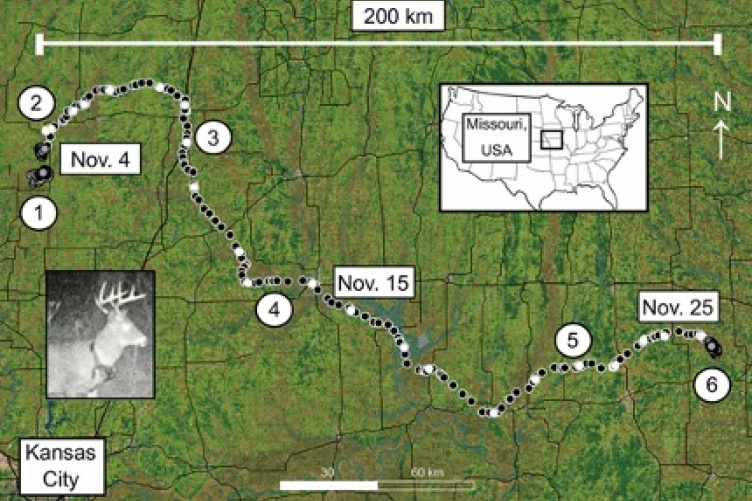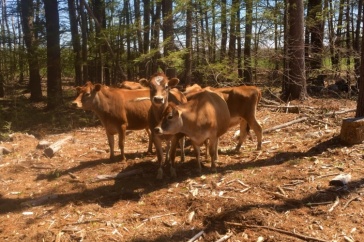
The record-setting 300-kilometer track of deer N17003, who started just north of Kansas City and crossed a major highway (3), a river (4) and railroads to traverse the state of Missouri.
A UNH researcher has discovered the longest travel distance ever recorded by an adult male white-tailed deer — 300 kilometers, or about 200 miles, in just three weeks. The study, led by assistant professor of wildlife ecology Remington Moll and published in the journal Ecology and Evolution, has important implications for population management and the transmission of disease, especially chronic wasting disease, in this iconic species. Nearly 8 million Americans hunt deer, contributing more than $20 billion to the U.S. economy.
“It looks like someone took the GPS collar and drove across the state of Missouri.”
Moll made this discovery as he analyzed data from GPS radio collars on more than 600 deer in Missouri; he began that research when he was a postdoctoral researcher at Michigan State University and is continuing to work on the project at UNH. “This extraordinary movement just jumped out,” he says. “We thought it was an error. It looks like someone took the GPS collar and drove across the state of Missouri.”
To confirm the findings, Moll and his coauthors surveyed the scientific literature for other dispersals — long-distance travel — of white-tailed deer (Odocoileus virginianus). The deer known as N17003 stood head and antlers above others; his walkabout was 174 kilometers longer than any other recorded for an adult male deer.
The findings were remarkable not only for the buck’s range — he roamed a distance equivalent to that from New York City to Baltimore, between the Missouri towns of Stanbury and Paris — but also because unlike juvenile males, who move to seek advantageous breeding opportunities, adult males tend to stay put. In his travels, between Nov. 4 and 22, 2017 N17003 crossed a major river seven times, an interstate highway, a railroad and eight state highways.

Why did this deer cross the road (and the river, and the railroad)? “We can only guess,” says Moll. “In some ways the study raises more questions than it answers: Why would it keep going, even passing by good habitat?” Moll surmises that hunting was a factor, since N17003 moved quickly at night but hunkered down during the day. “Deer know when it’s hunting season. They hear the first gunshots and they remember the year before,” he says, noting deer sometimes move into areas where hunting is not allowed.
Moll suspects that relatively newer technology like GPS collars is driving insights like this one. “We call this a rare event, but we haven’t been putting collars out for that long, and not in these large numbers,” he says. “It’s entirely possible that while this is an uncommon event, it could be happening with greater frequency than we’ve known.”
Understanding how and how far deer travel is important for managing the species and controlling chronic wasting disease, a fatal neurological disease spread by direct deer-to-deer contact and the environment. Knowing that deer are crossing county or even state lines highlights a need for regional management coordination.
Moll acknowledges that such a stunning finding in this common, well-studied species was unexpected. “Deer are one of the most abundant, well-known, intensely managed species of wildlife in the United States,” he says. “So to make this discovery despite all this attention is pretty surprising.”
Funding for this study is from the Missouri Department of Conservation, the U.S. Fish and Wildlife Service, and the University of Montana. Co-authors are Jon T. Roberts and Joshua J. Millspaugh, University of Montana; Kevyn H. Wiskirchen, Jason A. Sumners, Jason L. Isabelle and Barbara J. Keller, Missouri Department of Conservation; and Robert A. Montgomery, Michigan State University.
-
Written By:
Beth Potier | UNH Marketing | beth.potier@unh.edu | 2-1566

















































